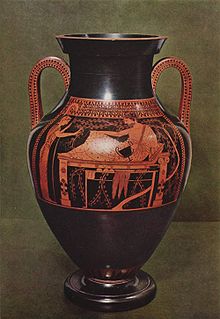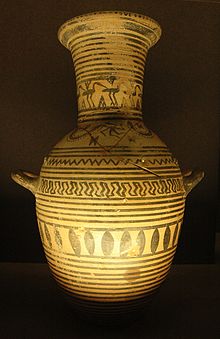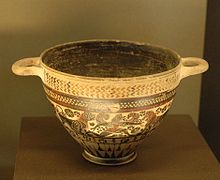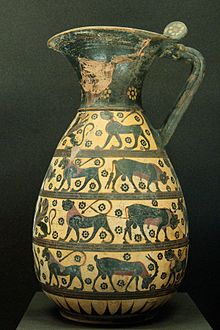- Pottery of ancient Greece
-
As the result of its relative durability, pottery is a large part of the archaeological record of Ancient Greece, and because there is so much of it (some 100,000 vases are recorded in the Corpus vasorum antiquorum) it has exerted a disproportionately large influence on our understanding of Greek society. Little survives, for example, of ancient Greek painting except for what is found on the earthenware in everyday use, so we must trace the development of Greek art through its vestiges on a derivative art form. Nevertheless the shards of pots discarded or buried in the first millennium BC are still the best guide we have to the customary life and mind of the ancient Greeks.
Contents
Aegean styles
Development of vase painting
Protogeometric styles
Vases of protogeometrical period (c. 1050-900 BC.) represent the return of craft production after the collapse of the Mycenaean Palace culture and the ensuing Greek dark ages. Indeed, it is one of the few modes of artistic expression besides jewelry in this period since the sculpture, monumental architecture and mural painting of this era are unknown to us. Yet by 1050 BC life in the Greek peninsula seems to have become sufficiently settled to allow a marked improvement in the production of earthenware. The style is confined to the rendering of circles, triangles, wavy lines and arcs, but placed with evident consideration and notable dexterity, probably aided by compass' and multiple brush.[1] Attic production was the first to resume and influence the rest of Greece, especially Boeotia, Corinth, the Cyclades (in particular Naxos) and the Ionian colonies in the east Aegean.[2] The site of Lefkandi is one of our most important sources of ceramics from this period where a cache of grave goods has been found giving evidence of a distinctive Euboian protogeometric which lasted into the early 8th century.[3]
Geometric style
Geometrical art flourished in the 9th and 8th centuries BC. It was characterized by new motifs, breaking with the iconography of the Minoan and Mycenaean periods: meanders, triangles and other geometrical decoration (from whence the name of the style) as distinct from the predominantly circular figures of the previous style. The best examples we have were grave goods, which often allows us to differentiate Attic, other mainland and island styles since we may assume they were produced in a batch for the sole purpose of burial. However our chronology comes from exported wares found in datable contexts overseas.
With the Early geometrical style (approximately 900-850 BC) one finds only abstract motifs, in what is called the “Black Dipylon” style, which is characterized by an extensive use of black varnish, with the Middle Geometrical (approx. 850-770 BC), figurative decoration makes its appearance: they are initially identical bands of animals (horses, stags, goats, geese, etc.) which alternate with the geometrical bands. In parallel, the decoration becomes complicated and becomes increasingly ornate; the painter feels reluctant to leave empty spaces and fills them with meanders or swastikas. This phase is named horror vacui and will not cease until the end of geometrical period.
In the middle of the century there begin to appear human figures. The best known representations of which are those of the vases found in Dipylon, one of the cemeteries of Athens. The fragments of these large funerary vases show mainly processions of chariots or warriors or of the funerary scenes: πρόθεσις / prothesis (exposure and lamentation of dead) or ἐκφορά / ekphora (transport of the coffin to the cemetery). The bodies are represented in a geometrical way except for the calves, which are rather protuberant. In the case of soldiers, a shield in form of a Diabolo, called “Dipylon shield” because of its characteristic drawing, covers the central part of the body. The legs and the necks of the horses, the wheels of the chariots are represented one beside the other without perspective. The hand of this painter, so called in the absence of signature, is the Dipylon Master, could be identified on several pieces, in particular monumental amphorae.[4]
At the end of the period there appear representations of mythology, probably at the moment when Homer codifies the traditions of Trojan cycle in the Iliad and the Odyssey. Here however, the interpretation constitutes a risk for the modern observer: a confrontation between two warriors can be as well a Homeric duel as a simple combat; a failed boat can represent the shipwreck of Odysseus or any hapless sailor.
Lastly, we have the local schools that appear in Greece. Production of vases was largely the prerogative of Athens - it is well attested that as in the proto-geometrical period, in Corinth, Boeotia, Argos, Crete and Cyclades, the painters and potters were satisfied to follow the Attic style. From about the 8th century BC on, they created their own styles, Argos specializing in the figurative scenes, Crete remaining attached to a more strict abstraction.[5]
Orientalizing style
The orientalizing style was the product of cultural ferment in the Aegean and Eastern Mediterranean of the 8th and 7th centuries BC. Fostered by trade links with the city-states of Asian Minor the artifacts of the East influenced a highly stylized yet recognizable representational art. Ivories, pottery and metalwork from the Neo-Hittite principalities of northern Syria and Phoenicia found their way to Greece, as did goods from Anatolian Urartu and Phrygia, yet there was little contact with the cultural centers of Egypt or Assyria. The new idiom developed initially in Corinth (as Proto-Corinthian) and later in Athens between circa 725 BC to 625 BC (as Proto-Attic).[6] It was characterized by an expanded vocabulary of motifs: sphinx, griffin, lions, etc., as well as a repertory of non-mythological animals arranged in friezes across the belly of the vase. In these friezes, painters also began to apply lotuses or palmettes. Depictions of humans were relatively rare. Those that have been found are figures in silhouette with some incised detail, perhaps the origin of the incised silhouette figures of the black-figure period. There is sufficient detail on these figures to allow scholars to discern a number of different artists' hands. Geometrical features remained in the style called proto-Corinthian that embraced these orientalizing experiments, yet which coexisted with a conservative sub-geometric style.
The ceramics of Corinth were exported all over Greece, and their technique arrived in Athens, prompting the development of a less markedly Eastern idiom there. During this time described as Proto-Attic, the orientalizing motifs appear but the features remain not very realistic. The painters show a preference for the typical scenes of the Geometrical Period, like processions of chariots. However, they adopt the principle of line drawing to replace the silhouette. In the middle of 7th century BC, there appears the black and white style: black figures on a white zone, accompanied by polychromy to render the color of the flesh or clothing. Clay used in Athens was much more orange than that of Corinth, and so did not lend itself as easily to the representation of flesh. Attic Orientalising Painters include the Analatos Painter, the Mesogeia Painter and the Polyphemos Painter.
Crete, and especially the islands of the Cyclades, are characterized by their attraction to the vases known as “plastic”, i.e. those whose paunch or collar is moulded in the shape of head of an animal or a man. At Aegina, the most popular form of the plastic vase is the head of the griffin. The Melanesian amphoras, manufactured at Paros, exhibit little knowledge of Corinthian developments. They present a marked taste for the epic composition and a horror vacui, which is expressed in an abundance of swastikas and meanders.
Finally one can identify the last major style of the period, that of Wild Goat Style, allotted traditionally to Rhodes because of an important discovery within the necropolis of Kameiros. In fact, it is widespread over all of Asia Minor, with centers of production at Miletos and Chios. Two forms prevail: oenochoes, which copied bronze models, and dishes, with or without feet. The decoration is organized in superimposed registers in which stylized animals, in particular of feral goats (from whence the name) pursue each other in friezes. Many decorative motifs (floral triangles, swastikas, etc.) fill the empty spaces.
Black figure
The black-figure period coincides approximately with the era designated by Winkelmann as the middle to late Archaic, from c. 620 to 480 BC. The technique of incising silhouetted figures with enlivening detail which we now call the black-figure method was, as we saw, a Corinthian invention of the 7th century[7] and spread from there to other city states and regions including Sparta,[8] Boeotia,[9] Euboea,[10] the east Greek islands[11] and Athens.
The Corinthian fabric, extensively studied by Humfry Payne[12] and Darrell Amyx,[13] can be traced though the parallel treatment of animal and human figures. The animal motifs have greater prominence on the vase and show the greatest experimentation in the early phase of Corinthian black-figure. As Corinthian artists gained in confidence in their rendering of the human figure the animal frieze declined in size relative to the human scene during the middle to late phase. By the mid 6th century BC, the quality of Corinthian ware had fallen away significantly to the extent that some Corinthian potters would disguise their pots with a red slip in imitation of superior Athenian ware.
At Athens, researchers have found the earliest known examples of vase painters signing their work, the first being a Dinos by Sophilos (illus. below, BM c. 580), this perhaps indicative of their increasing ambition as artists in producing the monumental work demanded as grave markers, as for example with Kleitias’s François Vase. Many scholars consider the finest work in the style to belong Exekias and the Amasis Painter, who are noted for their feeling for composition and narrative.
Circa 520 BC the red-figure technique was developed and was gradually introduced in the form of the bilingual vase by the Andokides Painter, Oltos and Psiax.[14] Red-figure quickly eclipsed black-figure yet in the unique form of the Panathanaic Amphora, black-figure continued to be utilised well into the 4th century BC.
Red figure
The innovation of the red-figure technique was an Athenian invention of the late 6th century. The ability to render detail by direct painting rather than incision offered new expressive possibilities to artists such as three-quarter profiles, greater anatomical detail and the representation of perspective. The first generation of red-figure painters worked in both red- and black-figure as well as other methods including Six's technique and white ground; the latter was developed at the same time as red-figure. However, within twenty years, experimentation had given way to specialization as seen in the vases of the Pioneer Group, whose figural work was exclusively in red-figure, though they retained the use of black-figure for some early floral ornamentation. The shared values and goals of The Pioneers such as Euphronios and Euthymides signal that they were something approaching a self-conscious movement, though they left behind no testament other than their own work. John Boardman said of the research on their work that "the reconstruction of their careers, common purpose, even rivalries, can be taken as an archaeological triumph"[15]
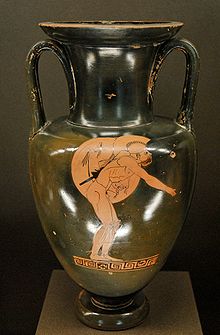 Neck amphora depicting an athlete running the hoplitodromos by the Berlin Painter, ca. 480 BC, Louvre
Neck amphora depicting an athlete running the hoplitodromos by the Berlin Painter, ca. 480 BC, Louvre
The next generation of late Archaic vase painters (ca. 500 to 480 BC) brought an increasing naturalism to the style as seen in the gradual change of the profile eye. This phase also sees the specialization of painters into pot and cup painters, with the Berlin and Kleophrades Painters notable in the former category and Douris and Onesimos in the latter.
By the early to high classical era of red-figure painting (c. 480 to 425 BC), a number of distinct schools had evolved. The mannerists associated with the workshop of Myson and exemplified by the Pan Painter hold to the archaic features of stiff drapery and awkward poses and combine that with exaggerated gestures. By contrast, the school of the Berlin Painter in the form of the Achilles Painter and his peers (who may have been the Berlin Painter’s pupils) favoured a naturalistic pose usually of a single figure against a solid black background or of restrained white-ground lekythoi. Polygnotos and the Kleophon Painter can be included in the school of the Niobid Painter, as their work indicates something of the influence of the Parthenon sculptures both in theme (e.g., Polygnotos’s centauromachy, Brussels, Musées Royaux A. & Hist., A 134) and in feeling for composition.
Toward the end of the century, the "Rich" style of Attic sculpture as seen in the Nike Balustrade is reflected in contemporary vase painting with an ever greater attention to incidental detail, such as hair and jewellery. The Meidias Painter is usually most closely identified with this style.
Vase production in Athens stopped around 330-320 BC possibly due to Alexander’s control of the city, and had been in slow decline over the 4th century along with the political fortunes of Athens itself. However, vase production continued in the 4th and 3rd centuries in the Greek colonies of southern Italy where five regional styles may be distinguished. These are the Apulian, Lucanian, Sicilian, Campanian and Paestan. Red-figure work flourished there with the distinctive addition of polychromatic painting and in the case of the Black Sea colony of Panticapeum the gilded work of the Kerch Style. Several noteworthy artists’ work comes down to us including the Darius Painter and the Underworld Painter, both active in the late 4th century, whose crowded polychromatic scenes often essay a complexity of emotion not attempted by earlier painters. Their work represents a late mannerist phase to the achievement of Greek vase painting.
White ground technique
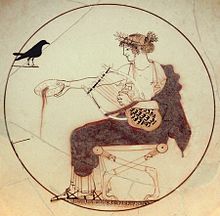 Apollo and his raven on a white-ground bowl by the Pistoxenos Painter. Delphi Archaeological Museum.
Apollo and his raven on a white-ground bowl by the Pistoxenos Painter. Delphi Archaeological Museum.
The white-ground technique was developed at the end of the sixth century BC. Unlike the better-known black-figure and red-figure techniques, its coloration was not achieved through the application and firing of slips but through the use of paints and gilding on a surface of white clay. It allowed for a higher level of polychromy than the other techniques, although the vases end up less visually striking. The technique gained great importance during the fifth and fourth centuries, especially in the form of small lekythoi that became typical grave offerings. Important representatives include its inventor, the Achilles Painter, as well as Psiax, the Pistoxenos Painter and the Thanatos Painter.
Hellenistic Period
The Hellenistic period (which we take to be roughly the late 4th century to the 1st century BC) is one of cultural decline in the traditional centres of Greek pottery production. Red-figure painting had died out in Athens by the end of the 4th century BC to be replaced by what is known as West Slope ware, so named after the finds on the west slope of the Athenian Acropolis. This latter style consisted of painting in a tan coloured slip and white paint on a fired black slip background with some incised detailing, representations of people diminished with this idiom to be replaced with simpler motifs such as wreaths, dolphins, rosettes, etc. Variations of this style spread throughout the Greek world with notable centres in Crete and Apulia, where figural scenes continued to be in demand. Bricks and tiles were used for architectural and other purposes. Several Greek styles continued into the Roman period, and Greek influence, partly transmitted via the Ancient Etruscans, on Ancient Roman pottery was considerable, especially in figurines.
Manufacture
Material
The process of making a pot and firing it is very simple. The first thing a potter needs is clay. When clay is first dug out of the ground it is full of rocks and shells and other stuff that needs to be removed. To do this the potter mixes the clay with water and lets all the impurities sink to the bottom. This is called levigation or elutriation. This process can be done many times. The more times this is done the smoother clay becomes after it is fired.
The clay is then kneaded by the potter and placed on a wheel. Once the clay is on the wheel the potter can shape it into any of the many shapes shown below or anything else he desires. The pots were usually made in sections such as the body and feet and spout. Even the body, if it were larger than 30 centimeters, might be made in separate sections and glued together later with a thin watery clay called slip.
After the pot is made then the potter paints it with a very pure black slip (made from the same clay) and a brush.
Greek pottery, unlike today's pottery, was only fired once, but that firing had three stages. After the pottery is stacked inside the kiln our potter can start the first stage. He heats the kiln up to around 800°C with all the vents on the sides open to let air in. This turns the pottery and the paint red all over. Once the kiln reaches 800°C the vents are closed and the temperature is raised to 950°C and then allowed to drop back to 900°C. This turns the pottery and the paint all black. The potter then starts the third and final phase by opening the vents and allowing the kiln to cool all the way down. This last phase leaves the slip black but turns the pottery back to red. This happens because when the clay is given air it turns red, but when the black slip is heated to 950°C it no longer allows air in. So the slipped area stays black while the bare areas stay red.
Construction
Wheelmade pottery dates back to roughly 2500 BC where before the coil method of building the walls of the pot was employed. Most Greek vases were wheelmade, though as with the Rhyton mould-made pieces (so-called "plastic" pieces) are also found and decorative elements either hand formed or by mould were added to thrown pots. More complex pieces were made in parts then assembled when it was leather hard by means of joining with a slip, where the potter returned to the wheel for the final shaping, or turning. It was then slipped and incised ready for the kiln.
Decoration and firing
The striking black slip with a metallic sheen, so characteristic of Greek pottery was a fine suspension (colloidal fraction) of an illitic clay with very low calcium oxide content which was rich in iron oxides and hydroxides, differentiating from that used for the body of the vase in terms of the calcium content, the exact mineral composition and the particle size. This clay suspension was most probably collected in situ from specially located illitic clay beds that produced spontaneous colloidal dispersion in rain water. The stability of the chemical composition of the Attic black slip argues against the use of added deffloculants such as wood or other plant ashes, urea, tannins, even blood, suggested by several authors during the 20th century. This clay suspension was thickened by concentration to a paste and was used for the decoration of the surface of the vase. The paint was applied on the areas intended to become black after firing.
The black color effect was achieved by means of changing the amount of oxygen present during firing. This was done in a single cycle, in a process known as three-phase firing. First, the kiln was heated to around 920-950°C, with all vents open bringing oxygen into the firing chamber and turning both pot and slip a reddish-brown (oxidising conditions) due to the formation of hematite (Fe2O3) in both the paint and the clay body. Then the vent was closed and green wood introduced, creating carbon monoxide which turns the red hematite to black magnetite(Fe3O4); at this stage the temperature decreases due to incomplete combustion. In a final reoxidizing phase (at about 800-850 °C) the kiln was opened and oxygen reintroduced causing the unslipped reserved clay to go back to orange-red. In the previous phase, chemical composition of the slipped surface had been altered, so it could no longer be oxidized and remained black. The technique which is mostly known as the "iron reduction technique" was decoded with the contribution of scholars, ceramists and scientists since the mid 18th cent. onwards to the end of 20th cent, i.e. Comte de Caylus(1752), Durand-Greville (1891), Binns and Fraser (1925), Schumann (1942), Winter (1959), Bimson (1956), Noble (1960, 1965), Hofmann (1962), Oberlies (1968), Pavicevic (1974), Aloupi (1993).[16]
Inscriptions
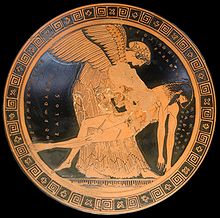 The so-called "Memnon pieta", Ancient Greek Attic red-figure cup, ca. 490–480 BC, from Capua. Inscriptions on the left: (ΕΕΝΕΜΕΚΝΕRΙΚΕ (this inscription doesn't make sense), HERMOΓΕΝΕS KALOS ("Hermogenes kalos" - "Hermogenes is fair"). Inscriptions on the right: HEOS ("Eos"), ΔΟRIS EΓRAΦSEN ("Doris Egraphsen" - Do(u)ris painted). Inscription on the right: MEMNON ("Memnon"), KALIAΔES EΠOIESEN ("Kaliades epoiesen" - Kaliades made). Musée du Louvre, G 155.
The so-called "Memnon pieta", Ancient Greek Attic red-figure cup, ca. 490–480 BC, from Capua. Inscriptions on the left: (ΕΕΝΕΜΕΚΝΕRΙΚΕ (this inscription doesn't make sense), HERMOΓΕΝΕS KALOS ("Hermogenes kalos" - "Hermogenes is fair"). Inscriptions on the right: HEOS ("Eos"), ΔΟRIS EΓRAΦSEN ("Doris Egraphsen" - Do(u)ris painted). Inscription on the right: MEMNON ("Memnon"), KALIAΔES EΠOIESEN ("Kaliades epoiesen" - Kaliades made). Musée du Louvre, G 155.
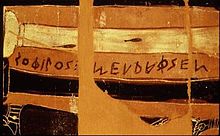 Signature (written retrograde) SOΦΙLOS MEΓΡΑΦSEN ("Sophilos megraphsen" - Sophilos drew me), ca. 570 BC., British Museum, GR 1971.11-1.1
Signature (written retrograde) SOΦΙLOS MEΓΡΑΦSEN ("Sophilos megraphsen" - Sophilos drew me), ca. 570 BC., British Museum, GR 1971.11-1.1
Inscriptions on Greek pottery are of two kinds; the incised (the earliest of which are contemporary with the beginnings of the Greek alphabet in the 8th century BC), and the painted, which only begin to appear a century later. Both forms are relatively common on painted vases until the Hellenistic period when the practice of inscribing pots seems to die out. They are by far most frequently found on Attic pottery. A number of sub-classes of inscription can be distinguished. Potters and painters occasionally signed their works with epoiesen and egraphsen respectively. Trademarks are found from the start of the 6th century on Corinthian pieces; these may have belonged to an exporting merchant rather than the pottery workfield and this remains a matter of conjecture.) Patrons' names are also sometimes recorded, as are the names of characters and objects depicted. At times we may find a snatch of dialogue to accompany a scene, as in ‘Dysniketos’s horse has won’, announces a herald on a Panathenaic amphora (BM, B 144). More puzzling, however, are the kalos and kalee inscriptions, which might have formed part of courtship ritual in Athenian high society, yet are found on a wide variety of vases not necessarily associated with a social setting. Finally there are abecedaria and nonsense inscriptions, though these are largely confined to black-figure pots.[17]
Some of the leading vase painters of Athens, such as the Pioneer Group, seem to have reveled in adding text to their vases and it is a testament to their literacy and cultural daring that they did so.
Rediscovery and scholarship
Interest in Greek art lagged behind the revival of classical scholarship during the Renaissance and revived in the academic circle round Nicholas Poussin in Rome in the 1630s. Though modest collections of vases recovered from ancient tombs in Italy were made in the 15th and 16th centuries these were regarded as Etruscan. It is possible that Lorenzo de Medici bought several Attic vases directly from Greece[18]; however the connection between them and the examples excavated in central Italy was not made until much later. Winckelmann's 'Geschichte der Kunst des Alterthums of 1764 first refuted the Etruscan origin of what we now know to be Greek pottery[19] yet Sir William Hamilton's two collections, one lost at sea the other now in the British Museum, were still published as "Etruscan vases"; it would take until 1837 with Stackelberg's Gräber der Hellenen to conclusively end the controversy.[20]
Much of the early study of Greek vases took the form of production of albums of the images they depict, however neither D'Hancarville's nor Tischbein's folios record the shapes or attempt to supply a date and are therefore unreliable as an archaeological record. Serious attempts at scholary study made steady progress over the 19th century starting with the founding of the Instituto di Corrispondenza in Rome in 1828 (later the German Archaeological Institute), followed by Eduard Gerhard's pioneering study Auserlesene Griechische Vasenbilder (1840 to 1858), the establishment of the journal Archaeologische Zeitung in 1843 and the Ecole d'Athens 1846. It was Gerhard who first outlined the chronology we now use, namely: Orientalizing (Geometric, Archaic), Black Figure, Red Figure, Polychromatic (Hellenistic). Finally it was Otto Jahn's 1854 catalogue Vasensammlung of the Pinakothek, Munich, that set the standard for the scientific description of Greek pottery, recording the shapes and inscriptions with a previously unseen fastidousness. Jahn's study was the standard textbook on the history and chronology of Greek pottery for many years, yet in common with Gerhard he dated the introduction of the red figure technique to a century later than was in fact the case. This error was corrected when the Aρχαιολογικη 'Εταιρεια undertook the excavation of the Acropolis in 1885 and discovered the so-called "Persian debris" of red figure pots destroyed by Persian invaders in 480 BC. With a more soundly established chronology it was possible for Adolf Furtwängler and his students in the 1880s and 90s to date the strata of his archaeological digs by the nature of the pottery found within them, a method of seriation Flinders Petrie was later to apply to unpainted Egyptian pottery.
Where the 19th century was a period of discovery and the laying out of first principles the 20th century has been one of consolidation and intellectual industry. Efforts to record and publish the totality of public collections of vases began with the creation of the Corpus vasorum antiquorum under Edmond Pottier and the Beazley archive. It is to John Beazley's comprehensive studies Attic Red-Figure Vase Painters 1942 and Attic Black-Figure Vase Painters 1956 we owe the naming of dozens of previously forgotten artists by Morellian stylistic analysis. Similarly Arthur Dale Trendall and Humfrey Payne along with Darrell A. Amyx supplied the chronology to the otherwise neglected Apulian and Corinthian schools.
Beazley and others following him have also studied fragments of Greek pottery in institutional collections, and have attributed many such pieces to artist. Scholars have called these fragments disjecta membra (Latin for "scattered parts") and in a number of instances have been able to identify fragments now in different collections that belong to the same vase.[21]
Uses and types of Ancient Greek pottery
Not all ancient Greek vases were purely utilitarian; large Geometric amphorae were used as grave markers, kraters in Apulia served as tomb offerings and Panathenaic Amphorae seem to have been looked on partly as objets d’art . Most other surviving pottery, however, had a practical purpose which determined its shape. The names we use for Greek vase shapes are often a matter of convention rather than historical fact, a few do illustrate their own use or are labeled with their original names, others are the result of early archaeologists attempt to reconcile the physical object with a known name from Greek literature – not always successfully. To understand the relationship between form and function Greek pottery may be divided in four broad categories:
- storage and transport vessels,
- mixing vessels,
- jugs and cups
- vases for oils, perfumes and cosmetics.
Within each category the forms are roughly the same in scale and whether open or closed, where there is uncertainty we can make good proximate guesses of what use a piece would have served. Some have a purely ritual function, for example white ground lekythoi contained the oil used as funerary offerings and appear to have been made solely with that object in mind. Many examples have a concealed second cup inside them to give the impression of being full of oil, as such they would have served no other useful gain.
There was an international market for Greek pottery since the 8th century BC, which Athens and Corinth dominated down to the end of the 4th century BC. An idea of the extent of this trade can be gleaned from plotting the find maps of these vases outside of Greece, though this could not account for gifts or immigration. Only the existence of a second hand market could account for the number of panathenaics found in Etruscan tombs. South Italian wares came to dominate the export trade in the Western Mediterranean as Athens declined in political importance during the Hellenistic period.
References
- ^ John K. Papadopoulos, James F. Vedder, Toby Schreiber, Drawing Circles: Experimental Archaeology and the Pivoted Multiple Brush, American Journal of Archaeology, Vol. 102, No. 3 (Jul., 1998), pp. 507-529
- ^ The diffusion of protogemetric pottery is a complex subject best summerized by V. Desborough, Protogeometric Pottery, 1952. The picture is further complicated by the presence of a lingering sub-Mycenaean style in some Greek centres during this period, see Desborough, The Last Mycenaeans and their Successors: An Archaeological Survey, c. 1200 - c. 1000 B.C, 1964
- ^ Anthony M. Snodgrass, The Dark Age of Greece, 2001, p.102. See also Popham, Sackett, Excavations at Lefkandi, Euboea 1968
- ^ The relationship between the iconography of grave markers and social change is essayed in James Whitley Style and Society in Dark Age Greece, 1991. See also Gudrun Ahlberg, Gudrun Ahlberg-Cornell, Prothesis and Ekphora in Greek Geometric Art, 1971.
- ^ Diffusion of the style is detailed in John Nicolas Coldstream, Greek Geometric Pottery: A Survey of Ten Local Styles and Their Chronology, 1968
- ^ Robert Manuel Cook,Greek Painted Pottery ,1997 , p.43.
- ^ The terminus ante quem of the late Corinthian black-figure style was established by M. T. Campbell A Well of the Black-figured Period at Corinth, Hesperia, vii (1938), pp. 557–611.
- ^ C. M. Stibbe Lakonische Vasenmaler des sechsten Jahrhunderts v.chr., 2 vols, 1972. M. Pipili Laconian Iconography of the Sixth Century BC, 1987
- ^ K. Kilinski II Boiotian Black Figure Vase Painting of the Archaic Period, 1990
- ^ J. Boardman Pottery from Eretria, Annu. Brit. Sch. Athens, xlvii, 1952, pp. 1–48
- ^ R. M. Cook and P. Dupont East Greek Pottery, 1998
- ^ H. G. G. Payne Necrocorinthia: A Study of Corinthian Art in the Archaic Period, 1931.
- ^ D. A. Amyx, Corinthian Vase-painting of the Archaic Period, 3 vols, 1991
- ^ However, the earliest red-figure vase was not a bilingual, see Beth Cohen, The Colors of Clay, p.21
- ^ J. Boardman: Athenian Red Figure Vases: The Archaic Period, 1975, p29.
- ^ For an extended review on the studies of Attic black slip and research published by several authors see R.E. Jones 1985, Tite M.S., M. Bimson and I. Freestone, An examination of the high Gloss Surface Finishes on Greek Attic and roman Samian Ware, Archaeometry 24.2(1982):117-26 and Aloupi-Siotis E., Recovery and Revival of Attic Vase-Decoration Techniques: What can they offer Archaeological Research?, in Papers on Special Techniques in Athenian Vases 2008: 113-128
- ^ Henry R. Immerwahr, Aspects of Literacy in the Athenian Ceramicus
- ^ A letter of 1491 to Lorenzo from Angelo Poliziano made an offer of 3 vases as an addition to an implied existing collection
- ^ Though the first conjecture belongs to A.S Mazochius, In regii herculanensis musaei tabulas hercleenes commentarii, 1754-8, however Winckelmann had access to greater resources including the first plates of the Hamilton collection. See D. von Bothmer, Greek vase-painting in Paper on the Amasis Painter and his World, 1987
- ^ Thanks to the ability of scholars to compare Greek finds with Italian ones following the Greek War of Independence, however the textual analysis in g. Kramer, Uber den Styl und die Herunft der bemalten griechischen Thongefasse 1837 and Otto Jahn's catalogue of the Vulci finds contributed to the changing consensus. See Cook, Greek Painted Pottery, 1997, p.283
- ^ Aaron J. Paul, Fragments of Antiquity: Drawing Upon Greek Vases, Harvard University Art Museums Bulletin, Vol. V, No. 2 (Spring 1997), pp.. 4, 10.
Bibliography
- John Beazley, Attic Black-Figure Vase Painters, Oxford University Press, Oxford, 1956.
- John Beazley, Attic Red-Figure Vase Painters, Oxford University Press, Oxford, 1942.
- John Beazley, The Development of Attic Black-Figure, University of California, 1951.
- John Beazley, Paralipomena, Oxford University Press, Oxford, 1971.
- John Boardman, Athenian Black figure Vases, London, 1974.
- John Boardman, Athenian Red Figure Vases, London, 1975.
- Coldstream, J. N., Geometric Greece 900-700 BC, London 2003 (Second Edition).
- Richard E. Jones: Greek and Cypriot Pottery: A Review of Scientific Studies. Athens 1985.
- Joseph Veach Noble: The Techniques of Painted Attic Pottery. New York 1965.
- Martin Robinson, The Art of Vase-Painting in Classical Athens, Cambridge, 1992.
- Arthur Dale Trendall, Red figure Vases of South Italy and Sicily, London, 1989.
- Adam Winter, Die Antike Glanztonkeramik', Mainz, 1978.
See also
- Ancient Roman pottery
- Greek Terracotta Figurines
- List of Greek Vase Painters
- Minoan pottery
- Tanagra figurine
External links
- Beazley Archive of Greek pottery
- Journey through art history: Ancient Greek Art
- S. Bleecker-Luce, A Brief History of the Study of Greek Vase Painting, American Philosophical Society 1918
Pottery of ancient Greece Wine shapes Perfume shapes and wedding shapes Funerary shapes and cultic shapes Storage shapes Techniques Painters Special topics in Greek pottery Typology · Kalos inscription · Symposium · Corpus Vasorum Antiquorum · John Beazley · Panathenaic Amphorae · South ItalianAncient Greece Periods Geography Politics Rulers - Kings of Sparta
- Kings of Athens
- Archons of Athens
- Kings of Macedon
- Kings of Pontus
- Kings of Paionia
- Roman Emperors
- Kings of Kommagene
- Kings of Lydia
- Attalid Kings of Pergamon
- Diadochi
- Kings of Argos
- Tyrants of Syracuse
Life - Agriculture
- Clothing
- Cuisine
- Democracy
- Economy
- Education
- Festivals
- Homosexuality
- Law
- Marriage
- Mourning ritual
- Olympic Games
- Pederasty
- Philosophy
- Prostitution
- Religion
- Slavery
- Warfare
- Wine
Military - Wars
- Army of Macedon
- Antigonid Macedonian army
- Pezhetairoi
- Hoplite
- Seleucid army
- Hellenistic armies
- Phalanx formation
- Peltast
- Sarissa
- Xyston
- Sacred Band of Thebes
People OthersGroups- Playwrights
- Poets
- Philosophers
- Tyrants
- Mythological figures
CulturesBuildings Arts - Architecture
- Coinage
- Literature
- Music
- Pottery
- Sculpture
- Theatre
Sciences Language Writing Lists - Cities in Epirus
- Theatres
- Cities
- Place names
Categories:- Ancient Greek pottery
- Ancient Greece
- Archaeology of Greece
- Economy of ancient Greece
Wikimedia Foundation. 2010.

